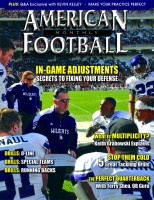Article CategoriesAFM Magazine
|
Multiplicity – Using Personnel Groupings to Enhance Your Offense and Player Moraleby: Keith GrabowskiOffensive Coordinator Baldwin-Wallace College © More from this issue After the 2004 season, my first as a head coach in a big high school program, we were faced with the challenge of pay-to-play. The coaching staff made a great effort in selling our program to athletes and parents, and we fielded the biggest roster in spite of the new pay-to-play obstacle. We also knew that in order to keep those numbers, we needed to re-evaluate how we were utilizing our players, especially in terms of playing time. We looked at the possibility of two platoon, and we wanted to move in that direction, but the program was not quite ready from both a staffing and personnel perspective. However, we knew that we had to find a way to play more than the 16 or 17 players who saw the field on a regular basis on Friday nights. This brought about my first experience with using personnel groupings on offense. Since then,....The full article can only be seen by subscribers.
|
|
|||||||
| HOME |
MAGAZINE |
SUBSCRIBE | ONLINE COLUMNISTS | COACHING VIDEOS |
Copyright 2026, AmericanFootballMonthly.com
All Rights Reserved





